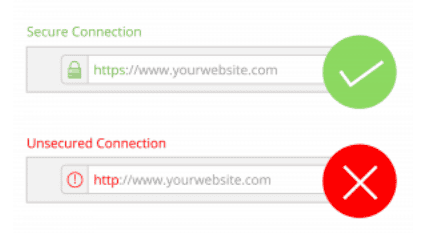Nearly everyone in today’s world has experienced cyber attacks. Evil actors try to fool you into believing that a website and its payment gateway are legitimate by taking advantage of the millions of dollars that are spent each day online purchasing.
It might be challenging to determine whether a website is trustworthy or a fraud. Surprisingly, there are a few simple ways to identify bogus websites.
How to tell if a website is phony, fraudulent, or a scam
Pay attention to the URL
The majority of individuals ignore or pay little attention to their browser address bar, which is a serious error that has to be corrected. Numerous important details about you and how safe your connection is can be found in the address bar.
The most common phishing approach involves building a website that cannot be distinguished from the legitimate one. Hackers construct sub-domains with identical domains to the main domain by copying the URL, and the user didn’t give it much thought.
You must understand how a URL is constructed in order to inspect it.
Keep an eye on the domain name most importantly, as many fraudulent websites employ minor variants that are readily mistaken for mistakes, such as onehealthsg.com (this is known as typosquatting).
Verify that the website is secure (there should be a small padlock before the URL); any website that does not use the HTTPS protocol and requests any kind of personal information from you should be regarded as dangerous.
The site’s image quality, the presence of grammar and spelling errors, the on-site review system, and especially their social media presence are additional warning signs that you should watch out for. Reputable brands and websites will generally try to maintain a healthy presence on a number of social media platforms.

The addition to the Hypertext Transfer Protocol known as HTTPS stands for Hypertext Transfer Protocol Secure. It’s used to communicate securely, and the Transport Layer is used to encrypt the discussion and make sure that only you and the website you’re connected to can listen in on it.
It’s also simple to determine whether a website is secure by looking for the “Green Padlock.” To a certain extent, it’s true, however it’s crucial to remember that the website that employs HTTPS is legitimate and completely protected from any flaws. That is not how it is! Recently, scammers and hackers have discovered a technique to utilize HTTPS to deceive prospective victims into believing they are secure.
The other method is by analyzing the URL of the website, several scams in Singapore target payment verification, email verification, or even social media login.
Using the 3 examples above, we need to first identify what the standard Website URL will look like.
Most websites will end with a
- .com
- .net
- .org
- .biz
- .sg
- .com.sg
- and for government websites, it will be ending with a
- .gov.sg
So now we look at the domain name, the example you receive an email or SMS and you think is fraud look at the URL, let us take XYZBank as an example
In most cases, the bank’s official website URL will be XYZBank.com or XYZBank.com.sg
If the URL link you get looks like this example
XYZBank.com.XYYZBANKSG.com then its likely to be a fake site as you should look at the URL before the .com
It could also be a fake website if the URL look like this XYZBankcom.com
Other ways these scammers uses links like XYZBank.com.1234566789.1wertfg3.com
in the current stage, most of them are not real as the original name is XYZBank.com
In the above scenario, you can see the fake websites are identified as such
For this URL XYZBank.com.1234566789.1wertfg3.com
the actual URL of this is 1wertfg3.com
For this URL
XYZBankcom.com You can see that the word com appears twice
and for this URL
XYZBank.com.XYYZBANKSG.com
the actual URL of this is actually XYYZBANKSG.com
If at anything you are unsure of the link, contact your institution first to verify the legitimacy of the website.
Protect yourself and your loved ones by getting reliable antivirus software that can detect and prevent such cyber crimes from happening to you. Click here to purchase the protection for your computer / Mobile phone.
Personally, we recommend the following
Kaspersky Total Security 2022 – 1-Year / 1-Device
AVG Ultimate – 2 Years / Unlimited Devices – Global
Norton 360 Deluxe – 1-Year / 3-Device
Though it may be difficult to completely avoid being scammed online, there are steps that you can take to reduce your chances of falling victim to one of these attacks. By understanding how cybercriminals operate and what they are looking for, you can be more cautious when entering your personal information into a website or making an online purchase.
Additionally, spreading awareness about these types of scams can help others become more informed and less likely to fall prey to them. If you have been the victim of a scam in the past or know someone who has, share this blog post with them and help prevent someone else from going through the same experience.

